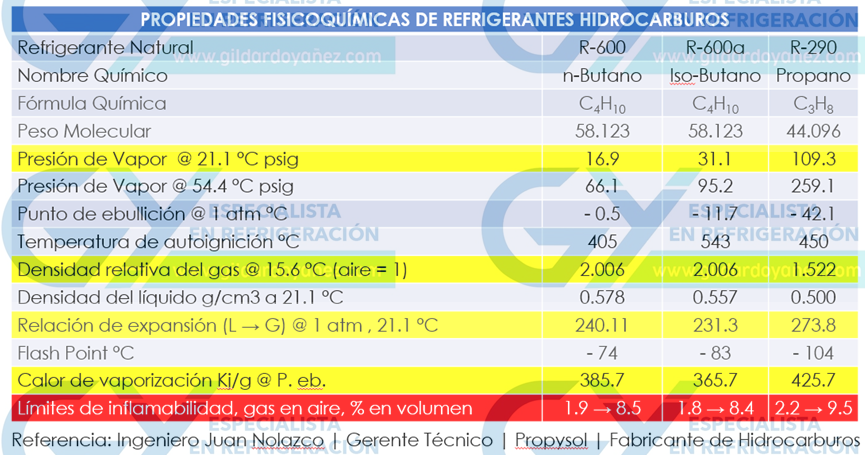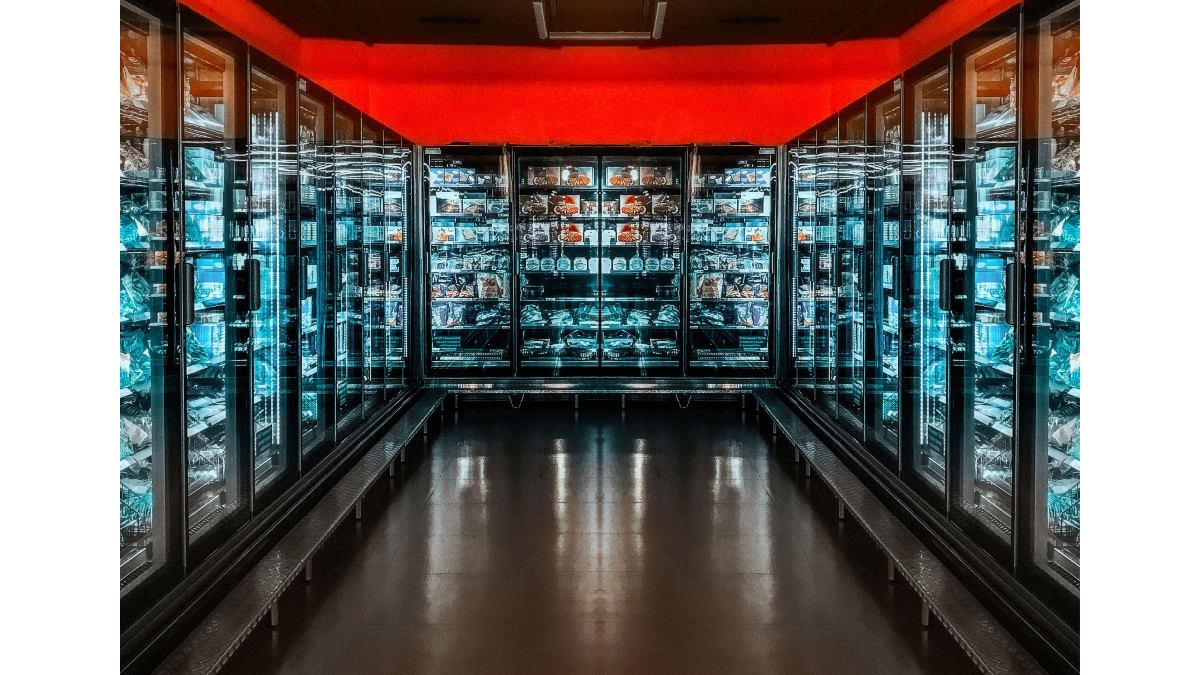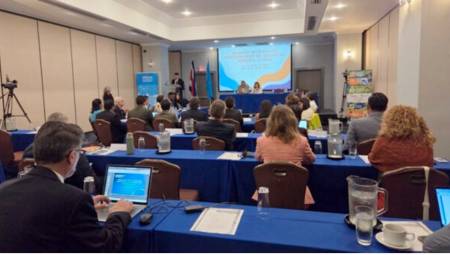Analyzing the Physicochemical Properties of Natural Flammable Refrigerants Hydrocarbons ASHRAE Safety Classification A3 | R-600a and R290.
by Eng. Gildardo Yáñez*
HC refrigerants are components of petroleum and natural gas found in nature. Although hydrocarbon refrigerants have excellent environmental, thermodynamic, and thermophysical properties, these refrigerants are flammable.
It should be noted that the use of flammable refrigerants will always be limited and conditioned by the corresponding regulations and standards. This article shows their physicochemical properties, which make them different from equivalent synthetic refrigerants.
Boiling point to an atmosphere at the time of release
• R-600 = – 05 °C
• R-600a = -11.7 °C
• R-290 = -42.1 °C
Very high auto-ignition temperature
• R-600 = 405°C
• R-600a = 543°C
• R-290 = 450°C
Board
Compared to the density of air, hydrocarbon refrigerants are heavier than air. When these refrigerants are released into the environment, the gas will be overwhelmingly present on the floor.
• R-600 and R-600a are 2,006 times heavier (1 liter of R-600 or R-600a weighs 0.578 grams)
• R-290 1,522 times heavier (1 liter of R-290 weighs 500 grams)
Liquid-to-gas expansion ratio expands
• R-600 → 240 times
• R-600a → 231 times
• R-290 → 274 times
Heat of vaporization: This is the unit that measures the amount of heat that can be trapped by the refrigerant
• R-600a → 365.7 Kilo Joules per gram
• R-290 → 425 kilo Joules per gram
Flammability limits of gas in air
• R-600 is flammable at 1.9 to 8.5% concentration in air
• R-600a is flammable at 1.8 to 8.4% concentration in air
• R-290 is flammable at 2.2 to 9.5% concentration in air
R-290 Refrigerant
The hydrocarbon refrigerant R-290, or propane, has a zero ODP ozone depletion potential and a GWP global warming potential of less than 3.
Since it comes from petroleum, it is considered to be a natural refrigerant. It is a substitute for other refrigerants, with a large environmental impact, in small airtight systems, such as commercial refrigerators and freezers.
Natural hydrocarbon refrigerants not only offer a large reduction in direct emissions, but also increase the energy efficiency of the refrigeration cycle (reduce indirect emissions), which is an important step towards replacing and achieving the phase-out of hydrochlorofluorocarbons (HCFCs) and the phase-out of hydrofluorocarbons (HFCs) for Article 5 countries.
Differences Between R-290 and R-134a
• R-290 is a highly flammable refrigerant.
• In ASHRAE Standard 34 it is classified as A3
• R-22 and R-404A are non-flammable refrigerants
• In ASHRAE Standard 34 they are rated A1
• R-290 has pressures similar to those of R-22 or R-404A.
An evaporation pressure of –25°C corresponds approximately to:
• 190% R-134a
• 81% of R-404A
• 350% of R-600a
• At -25°C the pressure is almost the same for R-22
• The evaporator design should be similar to those of R-22 or R-404A.
The pressure level and critical temperature are almost like those of R-22. However, the discharge temperature is much lower. It works with higher pressure ratios, which means lower evaporation temperatures or higher suction gas temperatures.
Main changes in the different components that impact the cost of a new refrigeration system compared to an R-134a one:
• Increase in compressor size and cost.
• Energy savings, with a 10 percent efficiency increase.
• Lower refrigerant cost, as the required charge volume decreases significantly.
• More than 25 percent reduction in the cost of heat exchangers
• This is because their size decreases significantly.
• Increase in the cost of electrical components.
• R-290 has approximately 90% of the volumetric capacity of R-22 and 150% of R-134a at a condensing temperature of 45°C.
• A compressor with a volumetric displacement close to that of R-22 and 10% to 20% greater than for R-404A is required.
This is why the choice of R-290 leads to different system designs due to the different volumetric flows required for the same cooling requirement. It is not a retrofit coolant for any current cooling system.
R-600A Refrigerant
The hydrocarbon refrigerant R-600a, or Isobutane has a zero ODP ozone depletion potential and a GWP global warming potential of less than 3.
Isobutane (R-600a) has been used in freezers in the past. The characteristics of R-600a are different from those of R-134a used in household refrigerators.
Some of its features:
1. It has a good cooling capacity even when working with high condensing temperatures.
2. Only 45 percent gas charge is required to match the full power of an R-134a charge.
3. High sensitivity to deviations in load.
4. Improper loads lead to high energy consumption.
Differences Between R-600a, R-134a, and R12
R-600a is a highly flammable refrigerant
In ASHRAE Standard 34 it is rated A3
R-134a and R-12 are non-flammable refrigerants
In ASHRAE Standard 34 they are rated A1
An evaporation pressure of –25°C corresponds approximately to:
55% of R-134a
45% of R-12
This leads to having much lower work pressures than the previous ones
Evaporators in household refrigerators will therefore work below atmospheric pressure
This feature gives good cooling capacity even at high condensing temperatures
The main disadvantage of the R600a is its flammability. This involves determined handling and safety precautions. For an ignition to occur, two conditions must be met:
* Flammable mixture of gas and air
* An ignition or temperature source
The above two conditions must be presented together in order to have combustion
To avoid combustion, this combination must be avoided
The compressors for R600a have internal guards and PTC starting systems or special relays, all of which ensure that no sparks can occur near the compressor.
Any electrical cut-off switch element during normal operation is considered to be an ignition source. This includes thermostats, light door contacts, on/off devices, and other switches, such as quick freeze, compressor relays, external thermals, defrost clocks, etc.
All parts are considered ignition sources due to the possibility of leakage. This includes evaporators, condensers, door heaters, piping, and compressor.
The maximum refrigerant charge is set at 57 grams in the U.S. In Mexico, a domestic refrigeration system can be designed with a maximum load of 150 grams. By keeping the charge at a maximum of 25% of the minimum explosion level, which is approximately 8 g/m3 for standard kitchens, ignition risks are low even if the distribution of refrigerant, in the event of a leak, is uneven.
 * Electrical Engineer Specialist in Refrigeration | I Help Strengthen the Knowledge of Refrigeration Technicians | Blog | Courses | CONALEP Technician | ITTLA Engineer | UVM Master Degree.
* Electrical Engineer Specialist in Refrigeration | I Help Strengthen the Knowledge of Refrigeration Technicians | Blog | Courses | CONALEP Technician | ITTLA Engineer | UVM Master Degree.
Training Manager - Bohn de Mexico
[email protected]















